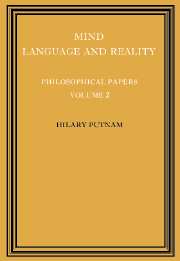Book contents
- Frontmatter
- Contents
- Dedication
- Introduction
- 1 Language and philosophy
- 2 The analytic and the synthetic
- 3 Do true assertions correspond to reality?
- 4 Some issues in the theory of grammar
- 5 The ‘innateness hypothesis’ and explanatory models in linguistics
- 6 How not to talk about meaning
- 7 Review ofThe concept of a person
- 8 Is semantics possible?
- 9 The refutation of conventionalism
- 10 Reply to Gerald Massey
- 11 Explanation and reference
- 12 The meaning of ‘meaning’
- 13 Language and reality
- 14 Philosophy and our mental life
- 15 Dreaming and ‘depth grammar’
- 16 Brains and behavior
- 17 Other minds
- 18 Minds and machines
- 19 Robots: machines or artificially created life?
- 20 The mental life of some machines
- 21 The nature of mental states
- 22 Logical positivism and the philosophy of mind
- Bibliography
- Index
3 - Do true assertions correspond to reality?
Published online by Cambridge University Press: 12 January 2010
- Frontmatter
- Contents
- Dedication
- Introduction
- 1 Language and philosophy
- 2 The analytic and the synthetic
- 3 Do true assertions correspond to reality?
- 4 Some issues in the theory of grammar
- 5 The ‘innateness hypothesis’ and explanatory models in linguistics
- 6 How not to talk about meaning
- 7 Review ofThe concept of a person
- 8 Is semantics possible?
- 9 The refutation of conventionalism
- 10 Reply to Gerald Massey
- 11 Explanation and reference
- 12 The meaning of ‘meaning’
- 13 Language and reality
- 14 Philosophy and our mental life
- 15 Dreaming and ‘depth grammar’
- 16 Brains and behavior
- 17 Other minds
- 18 Minds and machines
- 19 Robots: machines or artificially created life?
- 20 The mental life of some machines
- 21 The nature of mental states
- 22 Logical positivism and the philosophy of mind
- Bibliography
- Index
Summary
In this paper I want to explore the question: whether any sense can be made of the traditional view that a true assertion is one that corresponds to reality. Two opinions seem to be widespread: (a) that some sense can be made of the view, and that some sense is made of it (as much as can be hoped for) by Tarski's ‘Semantical Conception of Truth’; (b) that the view collapses as soon as one asks searching questions about the nature of the alleged ‘correspondence’. I shall try to show that both of these opinions are incorrect.
Tarski's conception of truth
According to Tarski, an adequate definition of ‘true as a sentence of English’ should have the feature that from it follows:
‘Snow is white’ is true as a sentence of English if and only if snow is white.
‘Grass is green’ is true as a sentence of English if and only if grass is green.
Tarski claims that this is a formalization of the ‘correspondence theory of truth’. But is it?
Assume for the moment that Tarski's Criterion of Adequacy (roughly described above) is correct. Even so, it seems to refer to purely interlinguistic aspects of the usage of ‘true’. This can be seen, for example, by observing that if the meta-language, say, ML, is only partially interpreted, we might still be able to certify a definition of ‘true as a sentence of L’ to be ‘adequate’ by checking that Tarski's Criterion of Adequacy was conformed to (all biconditionals of the form ‘S is true as a sentence of L ≡ S’ are theorems of ML where S is an arbitrary sentence of L and S is the name – or Gödel number – of S), even though the extra-logical constants of L are totally uninterpreted.
- Type
- Chapter
- Information
- Philosophical Papers , pp. 70 - 84Publisher: Cambridge University PressPrint publication year: 1975
- 9
- Cited by



